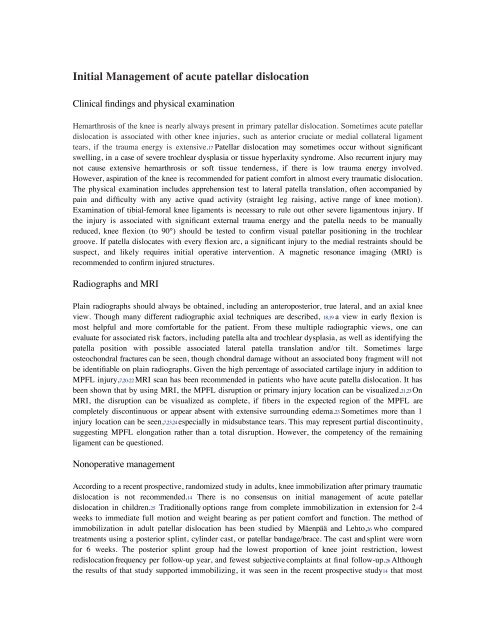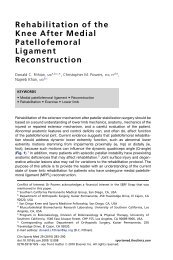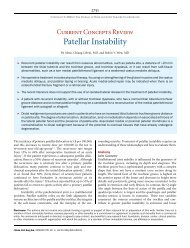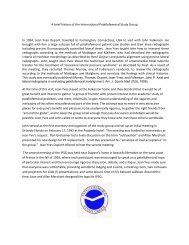Treatment of Patellar Dislocation in Children
Treatment of Patellar Dislocation in Children
Treatment of Patellar Dislocation in Children
You also want an ePaper? Increase the reach of your titles
YUMPU automatically turns print PDFs into web optimized ePapers that Google loves.
Initial Management <strong>of</strong> acute patellar dislocation<br />
Cl<strong>in</strong>ical f<strong>in</strong>d<strong>in</strong>gs and physical exam<strong>in</strong>ation<br />
Hemarthrosis <strong>of</strong> the knee is nearly always present <strong>in</strong> primary patellar dislocation. Sometimes acute patellar<br />
dislocation is associated with other knee <strong>in</strong>juries, such as anterior cruciate or medial collateral ligament<br />
tears, if the trauma energy is extensive.17 <strong>Patellar</strong> dislocation may sometimes occur without significant<br />
swell<strong>in</strong>g, <strong>in</strong> a case <strong>of</strong> severe trochlear dysplasia or tissue hyperlaxity syndrome. Also recurrent <strong>in</strong>jury may<br />
not cause extensive hemarthrosis or s<strong>of</strong>t tissue tenderness, if there is low trauma energy <strong>in</strong>volved.<br />
However, aspiration <strong>of</strong> the knee is recommended for patient comfort <strong>in</strong> almost every traumatic dislocation.<br />
The physical exam<strong>in</strong>ation <strong>in</strong>cludes apprehension test to lateral patella translation, <strong>of</strong>ten accompanied by<br />
pa<strong>in</strong> and difficulty with any active quad activity (straight leg rais<strong>in</strong>g, active range <strong>of</strong> knee motion).<br />
Exam<strong>in</strong>ation <strong>of</strong> tibial-femoral knee ligaments is necessary to rule out other severe ligamentous <strong>in</strong>jury. If<br />
the <strong>in</strong>jury is associated with significant external trauma energy and the patella needs to be manually<br />
reduced, knee flexion (to 90°) should be tested to confirm visual patellar position<strong>in</strong>g <strong>in</strong> the trochlear<br />
groove. If patella dislocates with every flexion arc, a significant <strong>in</strong>jury to the medial restra<strong>in</strong>ts should be<br />
suspect, and likely requires <strong>in</strong>itial operative <strong>in</strong>tervention. A magnetic resonance imag<strong>in</strong>g (MRI) is<br />
recommended to confirm <strong>in</strong>jured structures.<br />
Radiographs and MRI<br />
Pla<strong>in</strong> radiographs should always be obta<strong>in</strong>ed, <strong>in</strong>clud<strong>in</strong>g an anteroposterior, true lateral, and an axial knee<br />
view. Though many different radiographic axial techniques are described, 18,19 a view <strong>in</strong> early flexion is<br />
most helpful and more comfortable for the patient. From these multiple radiographic views, one can<br />
evaluate for associated risk factors, <strong>in</strong>clud<strong>in</strong>g patella alta and trochlear dysplasia, as well as identify<strong>in</strong>g the<br />
patella position with possible associated lateral patella translation and/or tilt. Sometimes large<br />
osteochondral fractures can be seen, though chondral damage without an associated bony fragment will not<br />
be identifiable on pla<strong>in</strong> radiographs. Given the high percentage <strong>of</strong> associated cartilage <strong>in</strong>jury <strong>in</strong> addition to<br />
MPFL <strong>in</strong>jury,7,20-22 MRI scan has been recommended <strong>in</strong> patients who have acute patella dislocation. It has<br />
been shown that by us<strong>in</strong>g MRI, the MPFL disruption or primary <strong>in</strong>jury location can be visualized.21,23 On<br />
MRI, the disruption can be visualized as complete, if fibers <strong>in</strong> the expected region <strong>of</strong> the MPFL are<br />
completely discont<strong>in</strong>uous or appear absent with extensive surround<strong>in</strong>g edema.23 Sometimes more than 1<br />
<strong>in</strong>jury location can be seen,7,23,24 especially <strong>in</strong> midsubstance tears. This may represent partial discont<strong>in</strong>uity,<br />
suggest<strong>in</strong>g MPFL elongation rather than a total disruption. However, the competency <strong>of</strong> the rema<strong>in</strong><strong>in</strong>g<br />
ligament can be questioned.<br />
Nonoperative management<br />
Accord<strong>in</strong>g to a recent prospective, randomized study <strong>in</strong> adults, knee immobilization after primary traumatic<br />
dislocation is not recommended.14 There is no consensus on <strong>in</strong>itial management <strong>of</strong> acute patellar<br />
dislocation <strong>in</strong> children.25 Traditionally options range from complete immobilization <strong>in</strong> extension for 2-4<br />
weeks to immediate full motion and weight bear<strong>in</strong>g as per patient comfort and function. The method <strong>of</strong><br />
immobilization <strong>in</strong> adult patellar dislocation has been studied by Mäenpää and Lehto,26 who compared<br />
treatments us<strong>in</strong>g a posterior spl<strong>in</strong>t, cyl<strong>in</strong>der cast, or patellar bandage/brace. The cast and spl<strong>in</strong>t were worn<br />
for 6 weeks. The posterior spl<strong>in</strong>t group had the lowest proportion <strong>of</strong> knee jo<strong>in</strong>t restriction, lowest<br />
redislocation frequency per follow-up year, and fewest subjective compla<strong>in</strong>ts at f<strong>in</strong>al follow-up.26 Although<br />
the results <strong>of</strong> that study supported immobiliz<strong>in</strong>g, it was seen <strong>in</strong> the recent prospective study14 that most






